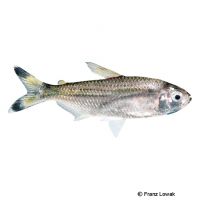Bandtail Tetra (Moenkhausia dichroura)
| Bandtail Tetra Moenkhausia dichroura | |
|---|---|
| Name | Bandtail Tetra |
| Name Lat. | Moenkhausia dichroura |
| Synonym | Tetragonopterus dichrourus |
| Family | Characins |
| Family lat. | Characidae |
| Order | Characins |
| Order lat. | Characiformes |
| Origin | South America |
| Habitat | Rivers |
| Diet | Omnivore |
| pH | 6.0-7.0 |
| Behavior | Peaceful |
| Keeping | Group |
| Care Level | Moderate |
| Reproduction | Egg scatterer |
| Breeding | None reported |
| Life Span | 3-5 years |
| Protection | No |
| Metric Units | |
| Size | 4-5 cm |
| Temperature | 22-26 °C |
| Hardness | 5-12 °dH |
| Aquarium | 80 l |
| US Units | |
| Size | 1.6"-2" |
| Temperature | 72-79 °F |
| Hardness | 89-214 ppm |
| Aquarium | 20 gal |
Distribution and habitat
Tail-spotted Moenkhausia are common in the Amazon basin in Guyana and Brazil, and in the Rio Paranagua and the Rio Paraguay. They live in clear, slow-flowing waters as well as floodplains with dense underwater vegetation and floating plants.
Maintenance
The aquarium should have a varied, partly dense planting, with shelters and hiding places (roots) and provide sufficient swimming space. A dark substrate covered with some foliage (e.g. sea almond leaves), shaded light (floating plants) and a weak current as well as soft, slightly acidic water is ideal.
No ammonia, ammonium and nitrite should be detectable, the nitrate value should not exceed 100 mg/l. To ensure the water quality and oxygen content, a filter and heater adapted to the aquarium size is required, as well as lighting for the species-appropriate day-night rhythm of the animals.
Diet
The food supply consists of live food, such as daphnia, cyclops, artemia and mosquito larvae, which is also eaten in frozen form, supplemented with frozen food mixtures. Dry food, such as flake and granulated food is also well accepted. In addition, they occasionally require vegetable food, such as crushed peas, mashed leafy and wild vegetables, or dry food with high vegetable content (spirulina, kelp).
Only feed as much as will be eaten within a few minutes. A regular and varied diet promotes health and prevents deficiency symptoms.
Behaviour and compatibility
They are peaceful and sociable fish that are well suited for any community tank. At least 5, but better more animals should be kept together.
Basically, only mutually compatible fish species with similar demands on water quality and water temperature may be socialized.
Sex dimorphism
Females appear slightly rounder. Males are more slender and they have a swim bladder that is slightly more pointed at the bottom.
Reproduction and breeding
There are no known reports of successful breeding in the aquarium. It is assumed that, similar to the other Moenkhausia species, they mostly spawn between fine-feathered plants (free spawners).
Important
In the long run, hard water above 12 °dGH is not tolerated
Moenkhausia dichroura are very similar to Moenkhausia intermedia.
The foliage (sea almond tree, oak, etc.) enriches the water with humic substances, naturally lowers the pH and, when rotting, promotes the development of microorganisms, which are a valuable secondary food source
The well-being of the fish should be monitored regularly. Temperature should be checked daily, pH, hardness and nitrate levels at least every 14 days. Regular partial water changes are recommended, even when contaminant levels have not yet reached the upper limit. Sudden changes in water quality should be avoided. Newly introduced fish must be accustomed slowly to the water in the aquarium.
Further literature can be found in your pet store.
References
Text: petdata; Image: Franz Lowak
Source: BMELV (1998): Tierschutzgutachten - Haltung von Zierfischen (Süßwasser); RIEHL & BAENSCH (2004): Aquarien Atlas Bd. 3, Mergus Verlag; ENGELMANN (2005): Zootierhaltung - Tiere in menschlicher Obhut: Fische, Verlag Harri Deutsch
- Gemäß § 21 Abs. 5 Tierschutzgesetz idgF
